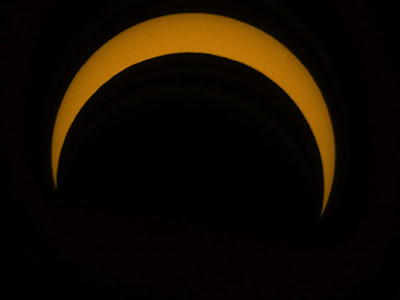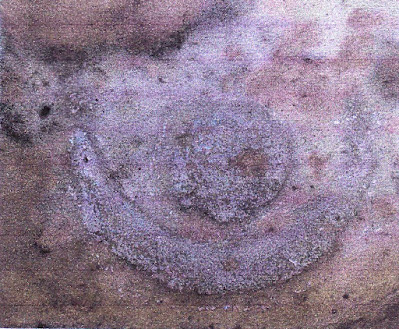I am writing this a little over a month after viewing the solar eclipse of 14 October 2023. Where I live the moon had covered 75-80 percent of the sun. During that viewing I tried to see if I could make out the partially obscured sun with my naked eyes – the answer is no. Even with that much of the sun obscured the remainder is so bright that it is all that you see - no shape, just bright light. This brought me to the question are there partial eclipses in rock art? My first reaction to this question would be no. The creators of the rock art would not have had the special glasses that are required to look at an eclipse without damaging your eyes.
I have, however, come up with one situation which I believe might let one see a partial eclipse without any accessories. A cloud cover of just the right density should block enough of the light allowing a viewer to see the partial eclipsing of the sun. So, perhaps there are some images of partial eclipses after all.
And even if
there were pictographs and petroglyphs of a partial eclipse how would we know
it? If it existed it would be a crescent image and crescents have always been
identified as lunar symbols in rock art studies.
We know that indigenous cultures knew of eclipses and had their explanations for what they were, and what they portended.
In North America, the Nootkans of Vancouver Island had their own explanation for eclipses. "The Nootkans saw evidence of spirits everywhere. They often prayed for power to the Four Chiefs of Above, Horizon, Land, and undersea. In a pleasant sky country was ka-u-c, the supreme controller of primary resources communicated with by chiefs only. Moon and Sun, husband and wife, were the highest powers for most, prayed to for food and luck, especially Moon. Swallowing of either by a great Sky Codfish caused eclipses. The Thunderbird's flapping wings made thunder, and lightning flashes were feathered serpents, his dogs." (Arima and Dewhirst 1990:404) They refer to “swallowing of either by a great Sky Codfish.” Presumably, a partial eclipse would be seen as the great Sky Codfish taking bites out of the Sun or Moon.
In 2017,
Love produced a paper on the Mayan “eclipse glyph” in which he gave examples
from various codices, arguing that the so-called “eclipse glyph” only
represents a real eclipse in the Dresden Codex and illustrated six examples of
these. He did not, however, refer to any of them as partial eclipses. I have
not seen any examples of these carved or painted on rock, but they might exist.
In 2021, Suarez and Garcia-Acosta wrote about earthquake records in the Aztec codex Telleriano-Remensis which also included a couple of illustrations of symbols that they identified as eclipse symbols. “The Codex Telleriano-Remensis, produced in sixteenth century Mexico on European paper, is one of the finest surviving examples of Aztec manuscript painting. It holds the earliest written evidence of earthquakes in the Americas. Its Latinized name comes from Charles-Maurice Le Tellier, archbishop of Reims, who had possession of the manuscript in the late 17th century. The Codex is held at the Bibliotheaaue national de France in Paris. The Codex Telleriano-Remensis is divided into three sections. The first section, spanning the first seven pages, describes the 365-day solar calendar, called the xiuhpohualli. The second section, spanning pages 8 to 24, is a tonalamatl, describing the 260-day tonalpohualli calendar. The third section is a history, itself divided into two sections which differ stylistically. Pages 25 to 28 are an account of migrations during the 12th and 13th centuries, while the remaining pages of the codex record historical events, such as the ascensions and deaths or rulers, battles, earthquakes, and eclipses, from the 14th century to the 16th century, including events of early Colonial Mexico.” (Wikipedia) This is another one to look for on the rocks.
So,
obviously my original assumption is wrong. If the Aztecs could record partial
eclipses in their Codeci, there may well be many other records going
unrecognized. While the Codex
Telleriano-Remensis is drawn on paper, not stone, it proves that indigenous
populations of the New World knew of partial solar eclipses, so yes, it is
possible that some of them are recorded on stone in rock art. This may mean
that some of the so-called lunar crescents on the rocks are actually meant to
record a partial solar eclipse.
One well
known example comes from Fern Cave in Lava Beds National Monument in
northeastern California. This panel has the dubious distinction of having been
branded a record of the A.D. 1054 Supernova which gave us the Crab Nebula. This
explanation has proliferated to the point that virtually any rock art that
includes a crescent and another spot, circle, or anything that can be believed
to represent a star has by now been so branded.
The most
famous example of this is the panel from the Penasco Blanco trail in Chaco
Canyon, New Mexico. But is this a supernova, the moon, or a partial eclipsed?
A couple from Buffalo Rock State Park in southern Illinois.
And one from the Fountain Bluff site, also in southern Illinois.
I have included a few examples of crescents in rock art. There are countless others, you probably know of many as well. Are these the crescent moon or are a few of them partial eclipses? I cannot say, but alternative possibilities should be kept in mind.
NOTE: Some images in this posting were retrieved from the internet with a search for public domain photographs. If any of these images are not intended to be public domain, I apologize, and will happily provide the picture credits if the owner will contact me with them. For further information on these reports you should read the original reports at the sites listed below.
REFERENCES:
Arima, Eugene, and John Dewhirst, 1990, Nootkans of Vancouver Island, 391-411, Sturtevant, William C. (general editor) and Suttles, Wayne (volume editor)1990 Handbook of North American Indians, Volume 7, Northwest Coast, 391-411, Smithsonian Institution, Washington.
Armitage, R.A., M. Hyman, J. Southon, C. Barat and M. W. Rowe, 1997, Rock-art image in Fern Cave, Lava Beds National Monument, California: not the AD 1054 (Crab Nebula) supernova, Antiquity 71, 715-719. Accessed 15 October 2023.
Love, Bruce, 2017, The “Eclipse Glyph” in Maya Text and Iconography: A Century of Misinterpretation, Ancient Mesoamerica, Cambridge University Press, pages 1-26. Accessed online 15 October 2023.
NASA, Eclipses: History, https://science.nasa.gov/eclipses/history/. Accessed online 14 October 2023.
Suarez, Gerardo, and Virginia Garcia-Acosta, 2021, The First Written Accounts of Pre-Hispanic Earthquakes in the Americas, November 2021, Seismological Research Letters, Vol. 92, No. 6.
Wikipedia, Codex Telleriano-Remensis, https://en.wikipedia.org/wiki/Codex_Telleriano-Remensis.
Accessed online 14 October 2023.














No comments:
Post a Comment